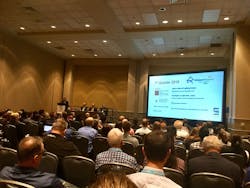Lightfair’s annual state of the industry presentation always offers a good snapshot of key market trends and the next wave of sales opportunities. It proved popular again this year, as it was standing-room only throughout the session on May 22.
Some attendees may have been surprised that presenters said sales of LEDs were showing signs of moderating over the next few years because the first wave of retrofit work is now complete. They quoted several different market studies that said the LED market is showing some signs of maturation, and said newer technologies like IoT, horticulture and the trend toward light & health now coming on the scene are not yet driving sales on the same scale as the first wave of LED retrofits.
Paula Ziegenbein, senior designer for Hartranft Lighting Design, said not as many new LED products are being introduced as in the past. She said one example of this trend is the declining number of entries over the past year for both Lightfair’s LFI Innovation Awards and the IES Progress Report.
Mark Lien, a regular presenter for the annual Lightfair Industry Update and the industry relations manager for the Illuminating Engineering Society (IES), focused on future technological trends that could impact the lighting market. He was particularly enthusiastic about the potential for augmented reality in the lighting market and said the newest generation of augmented reality glasses may one day become common in business meetings. These devices have apparently come a long way since Google’s first version of glasses, which never quite gained traction. Lien said that with the new augmented reality glasses, for example, you could be in a business meeting and have an attendee bio pop up in a small screen in the corner of the glasses so you would have more background on who’s at the meeting.
Lien also said lighting manufacturers will have to closely monitor data security for wireless lighting systems as hackers learn to use these systems as entry points into a company’s computer system. He did say that LFI technology — where light is used to transmit and receive data — may offer some exciting possibilities in data security because of the difficulty in hacking light waves.
About the Author
Jim Lucy
Editor-in-Chief of Electrical Wholesaling and Electrical Marketing
Jim Lucy has been wandering through the electrical market for more than 40 years, most of the time as an editor for Electrical Wholesaling and Electrical Marketing newsletter, and as a contributing writer for EC&M magazine During that time he and the editorial team for the publications have won numerous national awards for their coverage of the electrical business. He showed an early interest in electricity, when as a youth he had an idea for a hot dog cooker. Unfortunately, the first crude prototype malfunctioned and the arc nearly blew him out of his parents' basement.
Before becoming an editor for Electrical Wholesaling and Electrical Marketing, he earned a BA degree in journalism and a MA in communications from Glassboro State College, Glassboro, NJ., which is formerly best known as the site of the 1967 summit meeting between President Lyndon Johnson and Russian Premier Aleksei Nikolayevich Kosygin, and now best known as the New Jersey state college that changed its name in 1992 to Rowan University because of a generous $100 million donation by N.J. zillionaire industrialist Henry Rowan. Jim is a Brooklyn-born Jersey Guy happily transplanted with his wife and three sons in the fertile plains of Kansas for the past 30 years.
